 One of the things that makes the Princeton area so amazing is its diversity, including of cultures and religions. It is filled with places of worship for Christianity, Islam, Hinduism, Buddhism, Judaism and more. In fewer than 20 minutes driving down Rt. 27/Nassau Street you will pass a Buddhist temple, Hindu Mandir and Jewish Synagogues. You’ll drive by Presbyterian, Lutheran, Catholic and Episcopal Churches. And just a few yards further, you’ll find Princeton Theological Seminary.
One of the things that makes the Princeton area so amazing is its diversity, including of cultures and religions. It is filled with places of worship for Christianity, Islam, Hinduism, Buddhism, Judaism and more. In fewer than 20 minutes driving down Rt. 27/Nassau Street you will pass a Buddhist temple, Hindu Mandir and Jewish Synagogues. You’ll drive by Presbyterian, Lutheran, Catholic and Episcopal Churches. And just a few yards further, you’ll find Princeton Theological Seminary.
Beyond the spiritual opportunities they all offer, each also brings with it amazing architecture, community and opportunity. Here, we will highlight three such spaces found in the greater Princeton area, that provide for the needs of their own people as well as opening up to the community-at-large. In doing so, there are ways for us to learn more about who and what is around us; for us all to share experiences and understand each other a little better.
BAPS Swaminarayan Akshardham
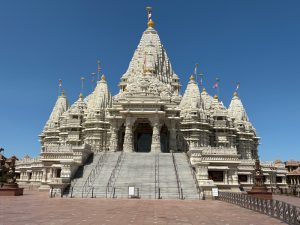 One site, found by travelling east to Robbinsville, was built to embrace the ideal that there is more that unites us than sets us apart. It is BAPS Swaminarayan Akshardham in Robbinsville, which was welcomed by its surrounding community when it fully opened in 2023. You will have to travel to India to find the only two other Akshardhams like it in the world. Built over millions of hours, by hand, with the help of 12,500 volunteers, the 185-acre campus is a sight to see. Its Robbinsville location was chosen because of its easy accessibility within the northeast, and within NJ, which has the largest concentration of Hindus in the United States.
One site, found by travelling east to Robbinsville, was built to embrace the ideal that there is more that unites us than sets us apart. It is BAPS Swaminarayan Akshardham in Robbinsville, which was welcomed by its surrounding community when it fully opened in 2023. You will have to travel to India to find the only two other Akshardhams like it in the world. Built over millions of hours, by hand, with the help of 12,500 volunteers, the 185-acre campus is a sight to see. Its Robbinsville location was chosen because of its easy accessibility within the northeast, and within NJ, which has the largest concentration of Hindus in the United States.
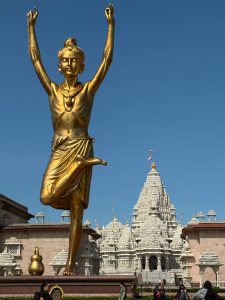 Upon arriving, you will approach a 49-foot sacred image of Bhagwan Swaminarayan, Founder and worshipped as god in the Swaminarayan tradition. Before him, you encounter a map of India, which follows the 7-year journey he took in the 1790s to uplift others. Standing in yoga pose, his golden image welcomes you to the spiritual campus.
Upon arriving, you will approach a 49-foot sacred image of Bhagwan Swaminarayan, Founder and worshipped as god in the Swaminarayan tradition. Before him, you encounter a map of India, which follows the 7-year journey he took in the 1790s to uplift others. Standing in yoga pose, his golden image welcomes you to the spiritual campus.
Before he died, Swaminarayan established a lineage of successors, and this Robbinsville campus was the vision of his 5th successor, Pramukh Swami Maharaj. He was vital in choosing the lot, which first opened with a section of spiritual assembly halls and a smaller mandir in 2012. But he passed in 2016 and never got to see it completed. It was his successor, Mahant Swami Maharaj, that was able to be there for the 2023 opening when it became a campus that includes Brahm Kund Pond at the front, and a Welcome Center adorned with 2,700 lamps in columns just behind it. As one approaches the Akshardham or grand mandir, granite lines the floor, sandstone is around the perimeter, limestone is outside of the building and the interior is marble – all sourced from around the world. Princeton local, Chaitali Inamdar, is one of the volunteers who spent four months working at the site and now dedicates time to help others appreciate it. She helped lay the grout around the floor outside the temple.
“I was born and brought up in the faith. It was part of my routine to come to mandir. In 2007, I was part of a national convention in a spiritually charged environment, and it became a part of me,” Inamdar explains. And then the opportunity arose to have a hand in building the Akshardham, she took it. “I wanted to do it for myself and my future. When else would I have an opportunity like this, to give to something much bigger than myself?”
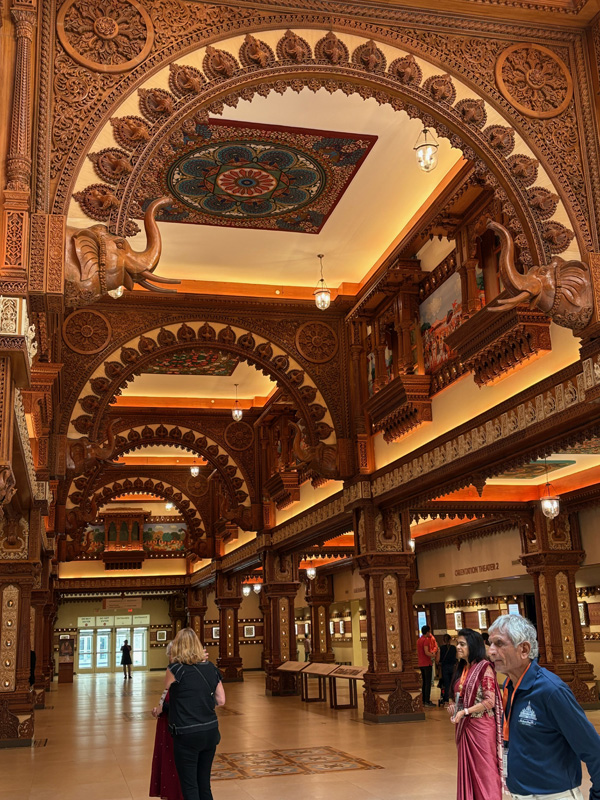 Nearly half of the visitors to the campus are non-Indian, so there is an opportunity to watch orientation videos in the welcome center, if wanted. Then, you can enter the main mandir, or temple, where you’ll take off your shoes and wash your hands, before coming upon the large central shrine of the 1st Spiritual leader, with a smaller statue of his 1st successor next to him. Beyond there, you will encounter shrines to 12 others, as well as tributes to some others who are worshipped in Hinduism. You can learn through the stories of 78 of the 500 people that took the journey with Swami Narayan. In all, there are more than 10,000 statues and statuettes depicting Hindu culture, 235 Mandapams (decorative stone canopies) and 548 stone pillars amongst other meaningful decorations. The orientation and design of the mandir was all dictated in scripture.
Nearly half of the visitors to the campus are non-Indian, so there is an opportunity to watch orientation videos in the welcome center, if wanted. Then, you can enter the main mandir, or temple, where you’ll take off your shoes and wash your hands, before coming upon the large central shrine of the 1st Spiritual leader, with a smaller statue of his 1st successor next to him. Beyond there, you will encounter shrines to 12 others, as well as tributes to some others who are worshipped in Hinduism. You can learn through the stories of 78 of the 500 people that took the journey with Swami Narayan. In all, there are more than 10,000 statues and statuettes depicting Hindu culture, 235 Mandapams (decorative stone canopies) and 548 stone pillars amongst other meaningful decorations. The orientation and design of the mandir was all dictated in scripture.
Careful pride was also taken to incorporate welcoming moments for non-Hindus, such as the inclusion of stained-glass windows, normally found in a church. The mandir also has positive messages along the outside wall, including those from Martin Luther King Jr. and Albert Einstein.
 Nearly everyone involved is a volunteer, and the hope is for it to be a holistic place to cherish traditions including spirituality, food, gathering and learning. BAPS Swaminarayan Akshardham Mandir is a unique opportunity in our back yard. There is no cost to enter but to help ensure a peaceful experience, an advance reservation system has been put in place where one can reserve timed-entry slots on weekends, national holidays and Hindu festivals.
Nearly everyone involved is a volunteer, and the hope is for it to be a holistic place to cherish traditions including spirituality, food, gathering and learning. BAPS Swaminarayan Akshardham Mandir is a unique opportunity in our back yard. There is no cost to enter but to help ensure a peaceful experience, an advance reservation system has been put in place where one can reserve timed-entry slots on weekends, national holidays and Hindu festivals.
The New Jersey Buddhist Vihara and Meditation Center
 If you travel north from Princeton up Route 27, you will find another impressive sight, at the only Buddhist temple in the area. It started with just a modest home, turned temple when The New Jersey Buddhist Vihara and Meditation Center first opened on the property in 2003. But it was when the largest Buddha statue in the Western Hemisphere was erected that this landmark became an attraction as well. Standing 30-feet tall, the Buddha was unveiled in 2009. Then in 2019, construction began on a new meditation center behind it. Creating a welcoming space for people of all religions to come for retreats, meditation, yoga, religious school, find peace and gather together for inter-faith dialogue. It is all the brainchild of Chief Incumbent Bhante H Sirirathana, the head monk.
If you travel north from Princeton up Route 27, you will find another impressive sight, at the only Buddhist temple in the area. It started with just a modest home, turned temple when The New Jersey Buddhist Vihara and Meditation Center first opened on the property in 2003. But it was when the largest Buddha statue in the Western Hemisphere was erected that this landmark became an attraction as well. Standing 30-feet tall, the Buddha was unveiled in 2009. Then in 2019, construction began on a new meditation center behind it. Creating a welcoming space for people of all religions to come for retreats, meditation, yoga, religious school, find peace and gather together for inter-faith dialogue. It is all the brainchild of Chief Incumbent Bhante H Sirirathana, the head monk.
“In all Buddhist temples in America, the Buddha statues are inside the temples. I had the idea to get the Buddha outside for people to see. Since the land is 10-acres, it allows for the right opportunity for people to see it,” Sirirathana shares.
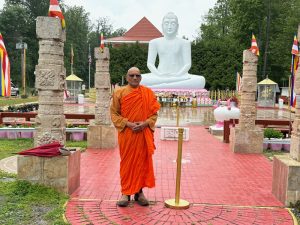 The very first image of Buddha, to represent Siddhartha Gautama, was not built until 500 years after his passing, so no one knows for sure if it truly looks like him. It is more about what he embodies, and you often find statues representing him in one of three poses. The statue on this property has Buddha in the “Samadhior ” sedentary meditating position. A sacred space for observant Buddhists, this center creates a sanctuary for all.
The very first image of Buddha, to represent Siddhartha Gautama, was not built until 500 years after his passing, so no one knows for sure if it truly looks like him. It is more about what he embodies, and you often find statues representing him in one of three poses. The statue on this property has Buddha in the “Samadhior ” sedentary meditating position. A sacred space for observant Buddhists, this center creates a sanctuary for all.
“We’re not trying to create Buddhists. This is about offering opportunities for people to come find peace. The Buddha was an enlightened human, a meditator. He found a path to be liberated from the cycle of suffering, and he taught this path for 45 years.”
Currently, The New Jersey Buddhist Vihara and Meditation Center welcomes approximately 100 visitors each day, especially in the summer months. People come by from all nations, though the temple is maintained by the Sri Lankan Buddhist community with most non-American visitors hailing from Nepal, Myanmar, China and Burma.
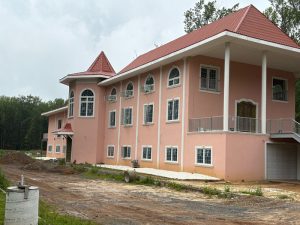 Everything on site is funded through contributions. Though work on the new meditation center began six years ago, COVID and financial issues led to delays in construction. There is hope that by the end of this year, the whole project will be complete. At that point, it will include the meditation hall, quarters for visiting monks as well as public gatherings. The original house will be removed and replaced with a meditation garden. It is all free to enjoy.
Everything on site is funded through contributions. Though work on the new meditation center began six years ago, COVID and financial issues led to delays in construction. There is hope that by the end of this year, the whole project will be complete. At that point, it will include the meditation hall, quarters for visiting monks as well as public gatherings. The original house will be removed and replaced with a meditation garden. It is all free to enjoy.
Princeton Theological Seminary

One could also wander around the campus freely, and take part in some of the offerings, at Princeton Theological Seminary (PTS). Situated along Stockton Street, Mercer and Alexander Roads, it is thought by those unfamiliar to be an extension of the Princeton University campus. But the Seminary is a separate institution like no other site in the area, as it is not simply a religious sanctuary nor a place of higher learning, it is both. While rooted in the Presbyterian tradition, its 350-person student body comes from around the world, and they pull from more than 50 Christian denominations. Preparing for leadership as pastors, chaplains, nonprofit leaders, church planters and more, the students go on to serve in congregations as well as working in public policy, nonprofit work, higher education and counseling. All aiming to be in service to the church with a commitment to their faith.
“At Princeton Seminary, students have learned that it is not enough to feed those who are hungry. We must also interrogate why some zip codes have devolved into unsustainable food deserts. It is not enough to pray for the sick. We also need ministers of the gospel who understand social determinants of health like education, poverty, housing, and affiliation. And it is not enough to welcome the stranger. We must learn to identify culturally encoded bigotries and biases that render some people strange in the first place,” Seminary President Jonathan Lee Walton reminded this year’s graduating class.
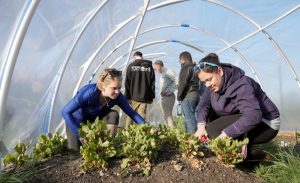
To prepare them to do so, they learn and participate on the main campus of PTS, which sits just off downtown Princeton, covering 27-acres. Ten years ago, the Farminary campus opened, a 21-acre working farm off Mercer Road where students also weave agriculture and ecological justice into their theological study. Its location in the heart of Princeton is essential to what it has become, pulling from both the nearby scholarship and the vibrant local opportunities.
With 36-fulltime faculty, both the instructors and the students take advantage of working with those in the greater-Princeton area through religious and nonprofit initiatives, and at local congregations. The community therefore benefits from bringing them in, but PTS also welcomes nearby residents onto its campus’ as well. The Farminary will be celebrating its 10th Anniversary with a weekend of speakers and events in late September, and all are invited to join. 1st Thursdays at the Farm are also hosted at The Farminary every month, where the community is invited to hear from scholars, artists and activists over a 4-course meal. On PTS’ main campus, there are frequent lectures and conferences opened to the public.
So why not take a day or a night this summer to learn from, take part in or simply observe a religious experience different from your own? These religious sites nearby offer not only beauty and innovation, but they truly want to welcome others in.

Lisa Jacknow spent years working in national and local news in and around New York City before moving to Princeton. Working as both a TV producer and news reporter, Lisa came to this area to focus on the local news of Mercer County at WZBN-TV. In recent years, she got immersed in the Princeton community by serving leadership roles at local schools in addition to volunteering for other local non-profits. In her free time, Lisa loves to spend time with her family, play tennis, sing and play the piano. A graduate of the S. I. Newhouse School of Public Communications at Syracuse University, Lisa was raised just north of Boston, Massachusetts but has lived in the tri-state area since college. She is excited to be Editor and head writer for Princeton Perspectives!
